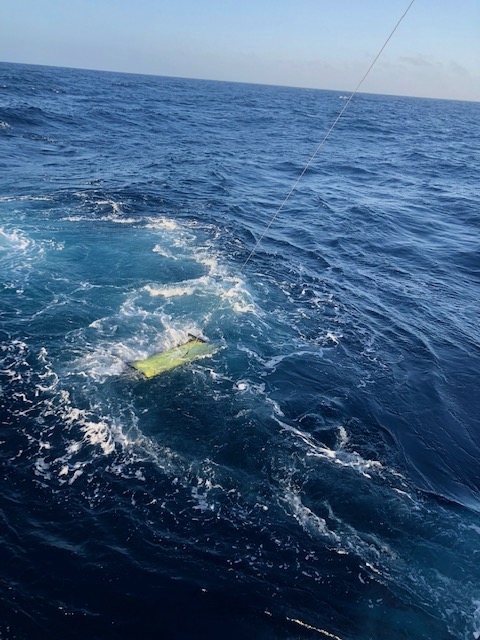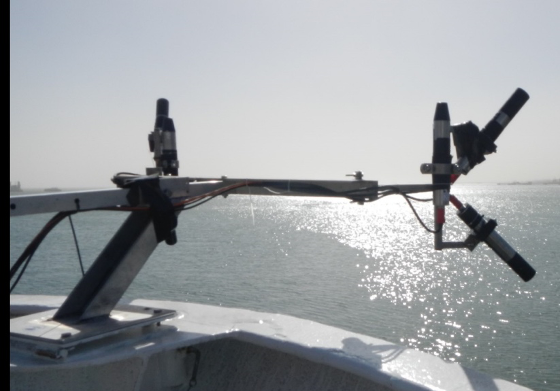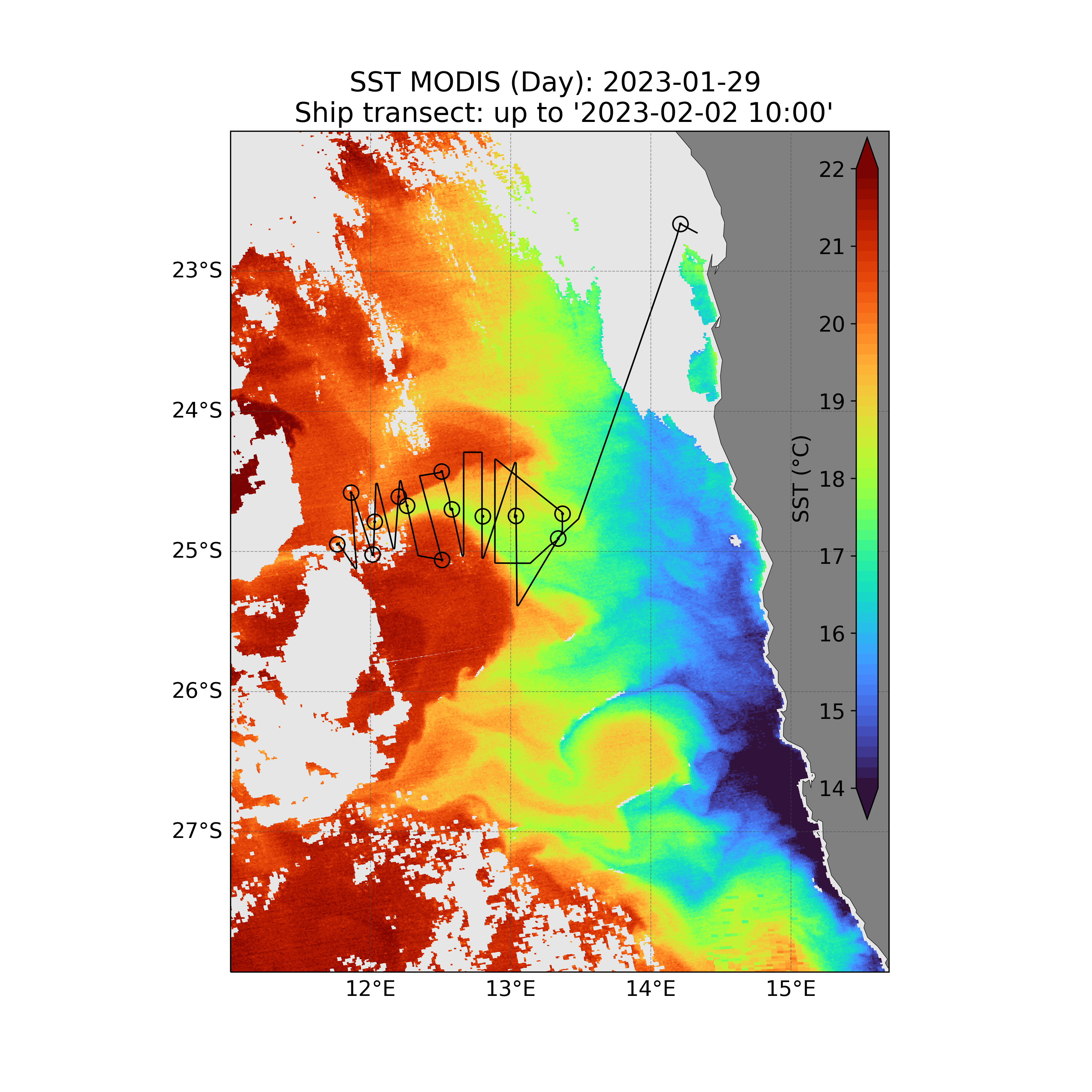+++ deutsche Version siehe unten+++
2nd weekly report (29.01.2023 – 04.02.2023)
Monday 6th February 2023
The second week of the research cruise M187 started with continued observation of the first targeted filament located around 24–25 °S. This filament has been a major and persistent feature in satellite images over the last few weeks, extending more than 200 km from the main upwelling region off Namibia outwards into the Southeast Atlantic. A total of seven stations located in the centre of the filament have been conducted, each with multiple deployments measuring physical, chemical and biological parameters throughout the water column. Stations were occupied daily, starting at around 08:30 ship time and lasting through to 15:30–17:00. Each station involved deployment of deep (1000 m) and shallow (100-120 m) CTD casts to collect water for chemical and biological samples including salinity, oxygen, nutrients (nitrate, phosphate, silicate, dissolved organic nutrients), trace gases (methane, nitrous oxide), nitrate isotopes, dissolved carbon, particulate carbon, phytoplankton concentrations, microbial genomics, and phytoplankton physiology. These were supplemented with the deployment of trace-metal-clean sampling bottles for collection of contamination-prone nutrient elements, such as iron, cobalt and zinc, as well as pumps deployed at 6-8 depths, which collect high particle loads for further chemical and biological analyses. Finally, hyperspectral light profiles and Secchi disk deployments were conducted to measure optical properties of the water.
Following each of the daily stations, we continued sailing in a zigzag fashion through the filament, to map many of these parameters across and outside of the filament. At 16:00 ship time on the 31st January, we deployed the Scanfish for the first time. The Scanfish is a device deployed off the A-frame at the aft of the ship, connected via a conducting cable to a winch fitted to the ship’s deck. Via movement of its wings, the device moves up and down through the water column between the surface and ~130 m whilst the ship is sailing. The Scanfish is equipped with several sensors including temperature, salinity, oxygen, and chlorophyll fluorescence. Deployments therefore allow for high resolution, depth-resolved observations whist sailing across the filament. The Scanfish was successfully deployed and operated for several hours. However, at around 23:30 ship time the Scanfish winch failed, resulting in the cable rapidly unwinding and eventual breaking from the winch, resulting in loss of the Scanfish. The exact cause of the winch failure is still being investigated.

In addition to the underway water samples being collected as we sail across the filament, we are also measuring seawater optical properties continuously using above-water hyperspectral radiometry. These radiometers are placed at the bow of the research vessel pointing both towards the sea surface and to the sky. These observations replicate those made by sensors on earth-orbiting satellites recording ocean colour. By collecting samples at sea alongside the shipboard radiometry measurements, this will allow us to better understand what information the satellites are providing. Ultimately, we hope to be able to use these signals to tell us which types of phytoplankton are living in different regions of the ocean and also provide information about their physiological status (health). Via satellite observations, these data would then be available at much larger spatial and temporal scales than we can cover on a research vessel.

On Thursday 2nd February the daily station was ended early, as one of the ship’s crew had fallen sick and it was necessary to return to Walvis Bay for a medical evacuation. We arrived in Walvis Bay early on 3rd of February and are now waiting for a replacement crew member to join the ship.
We continue to be very well looked after by Captain Korte and the rest of the ships team, the weather has been favourable, and the food excellent. Despite the very unfortunate loss of the Scanfish device earlier in the week, and subsequently the medical evacuation, the remainder of the research activities have proceeded very well up to this point. We are fortunate that we were reaching the end of our first filament study when the research activities had to be put on hold. We look forward to continuing soon!
With best regards from Walvis Bay, Namibia,
Tom Browning GEOMAR Helmholtz Centre for Ocean Research Kiel
+++Deutsche Fassung+++
Verfolgung der biogeochemischen Entwicklung eines Ozeanfilaments
2. Wochenbericht (29.01.2023 – 04.02.2023)
Die zweite Woche der Forschungsfahrt M187 begann mit der weiteren Beobachtung des ersten Filaments bei 24-25°S. Dieses Filament war in den letzten Wochen auf Satellitenbildern deutlich zu erkennen und erstreckt sich über 200 km vom Hauptauftriebsgebiet vor Namibia hinaus in den Südostatlantik. Es wurden insgesamt sieben Stationen im Zentrum des Filaments durchgeführt, wobei jede Station mehrere Messungen physikalischer, chemischer und biologischer Parameter in der gesamten Wassersäule durchführte. Die Stationen wurden täglich besetzt, beginnend um ca. 08:30 Uhr Schiffszeit und dauernd bis 15:30-17:00 Uhr. An jeder Station wurden tiefe (1000 m) und flache (100-120 m) CTDs durchgeführt, um Wasser für chemische und biologische Proben zu sammeln, darunter Salzgehalt, Sauerstoff, Nährstoffe (Nitrat, Phosphat, Silikat, gelöste organische Nährstoffe), Spurengase (Methan, Distickstoffoxid), Nitratisotope, gelöster Kohlenstoff, partikulärer Kohlenstoff, Phytoplanktonkonzentrationen, mikrobielle Genomik und Phytoplanktonphysiologie. Ergänzend dazu wurden saubere Probenahmeflaschen zur Sammlung kontaminationsanfälliger Nährstoffe wie Eisen, Kobalt und Zink sowie Pumpen in 6-8 Tiefen eingesetzt, die hohe Partikelmengen für weitere chemische und biologische Analysen zu sammeln. Schließlich wurden hyperspektrale Lichtprofile und Secchi-Scheibenmessungen durchgeführt, um die optischen Eigenschaften des Wassers zu messen.

Nach jeder der täglichen Stationen fuhren wir im Zickzackkurs weiter durch das Filament, um viele dieser Parameter innerhalb und außerhalb des Filaments zu erfassen. Am 31. Januar um 16:00 Uhr Schiffszeit setzten wir den Scanfish zum ersten Mal aus. Der Scanfish ist ein Gerät, das vom A-Rahmen am Heck des Schiffes aus eingesetzt wird und über ein Kabel mit einer Winde an Deck des Schiffes verbunden ist. Durch die Bewegung seiner Flügel bewegt sich das Gerät in der Wassersäule zwischen der Oberfläche und ~130 m auf und ab, während das Schiff unterwegs ist. Der Scanfish ist mit mehreren Sensoren ausgestattet, darunter Temperatur, Salzgehalt, Sauerstoff und Chlorophyll-Fluoreszenz. Die Einsätze ermöglichen daher hochauflösende, tiefenaufgelöste Beobachtungen, während sie über das Filament fahren. Der Scanfish wurde erfolgreich eingesetzt und war mehrere Stunden lang in Betrieb. Allerdings versagte gegen 23:30 Uhr Schiffszeit die Scanfish-Winde, was dazu führte, dass sich das Kabel schnell abwickelte und schließlich von der Winde riss, was den Verlust des Scanfish zur Folge hatte. Die genaue Ursache für den Ausfall der Winde wird noch untersucht.

Zusätzlich zu den Wasserproben, die wir während der Fahrt durch das Filament sammeln, messen wir auch kontinuierlich die optischen Eigenschaften des Meerwassers mit Hilfe der hyperspektralen Radiometrie über Wasser. Diese Radiometer befinden sich am Bug des Forschungsschiffs und sind sowohl auf die Meeresoberfläche als auch auf den Himmel gerichtet. Diese Beobachtungen entsprechen denen von Sensoren auf Satelliten, die die Farbe des Ozeans aufzeichnen. Durch das Sammeln von Proben auf dem Meer parallel zu den radiometrischen Messungen an Bord des Schiffes können wir besser verstehen, welche Informationen die Satelliten liefern. Letztendlich hoffen wir, anhand dieser Signale feststellen zu können, welche Arten von Phytoplankton in den verschiedenen Regionen des Ozeans leben, und auch Informationen über ihren physiologischen Zustand (Gesundheit) zu erhalten. Über Satellitenbeobachtungen wären diese Daten dann in einem viel größeren räumlichen und zeitlichen Skalen verfügbar, als dies auf einem Forschungsschiff möglich wäre.

Am Donnerstag, dem 2. Februar, wurde die Tagesstation vorzeitig beendet, da ein Mitglied der Schiffsbesatzung erkrankt war und für eine medizinische Evakuierung nach Walvis Bay zurückkehren musste. Wir kamen am 3. Februar früh in Walvis Bay an und warten nun auf ein neues Besatzungsmitglied, das an Bord kommen soll.
Kapitän Korte und das gesamte Schiffsteam kümmern sich weiterhin sehr gut um uns, das Wetter war günstig und das Essen ausgezeichnet. Trotz des sehr unglücklichen Verlusts des Scanfish-Geräts Anfang der Woche und der anschließenden medizinischen Evakuierung sind die übrigen Forschungsaktivitäten bis jetzt sehr gut verlaufen. Wir hatten Glück, dass wir uns dem Ende unserer ersten Filamentstudie näherten, als die Forschungsaktivitäten auf Eis gelegt werden mussten. Wir freuen uns auf eine baldige Fortsetzung!
Mit besten Grüßen aus Walvis Bay, Namibia,
Tom Browning und die Teilnehmer der Forschungsfahrt von M187
